Comparison of Numerical and Experimental Studies for Flow-Field Optimization Based on Under-Rib Convection in Polymer Electrolyte Membrane Fuel Cells
Abstract
:1. Introduction
2. Experimental Procedure
2.1. Fuel Cell Assembly
2.2. Experimental Setup
3. Numerical Model
3.1. Governing Equations and Physical Models
3.2. Simulation Model Description and Computational Domain
3.3. Operating Equations
4. Results and Discussion
4.1. Effect of Flow-Field Design on Temperature and Pressure Distribution
4.2. Effect of Flow-Field Design on Water Formation and Discharge
4.3. Effect of Flow-Field Design on Fuel Cell Performance
5. Conclusions
Acknowledgments
Author Contributions
Conflicts of Interest
References
- Nguyen, V.D.; Lee, J.K.; Kim, K.C.; Ahn, J.W.; Park, S.H.; Kim, T.U.; Kim, H.M. Dynamic simulations of under-rib convection-driven flow-field configurations and comparison with experiment in polymer electrolyte membrane fuel cells. J. Power Sources 2015, 293, 447–457. [Google Scholar]
- Scott, H.; Amrit, C.; Robert, S.W. Fuel cell added value for early market applications. J. Power Sources 2015, 287, 297–306. [Google Scholar]
- Li, X.; Sabir, I. Review of bipolar plates in PEM fuel cells: Flow-field designs. Int. J. Hydrog. Energy 2005, 30, 359–371. [Google Scholar] [CrossRef]
- Óscar, G.E.; Teresa, J.L.; Emilio, N.A. Fuel cells: A real option for unmanned aerial vehicles propulsion. Sci. World J. 2014, 1. [Google Scholar] [CrossRef]
- Li, H.; Tang, Y.H.; Wang, Z.W.; Shi, Z.; Zhang, J.L.; Fatih, K.L.; Zhang, J.J.; Wang, H.J.; Liu, Z.H.; Abouatallah, R.; et al. A review of water flooding issues in the proton exchange membrane fuel cell. J. Power Sources 2008, 178, 103–117. [Google Scholar] [CrossRef]
- Iranzo, A.; Boillat, P.; Biesdorf, J.; Tapia, E.; Salva, A.; Guerra, J. Liquid water preferential accumulation in channels of PEM fuel cells with multiple serpentine flow fields. Int. J. Hydrog. Energy 2014, 39, 15687–15695. [Google Scholar] [CrossRef]
- Anderson, R.; Zhang, L.; Ding, Y.; Blanco, M.; Bi, X.; Wilkinson, D.P. A critical review of two-phase flow in gas flow channels of proton exchange. J. Power Sources 2010, 195, 4531–4553. [Google Scholar] [CrossRef]
- Hontaon, E.; Escudero, M.J.; Bautista, C.; Garcia-Ybarra, P.L.; Daza, L. Optimisation of flow-field in polymer electrolyte membrane fuel cells using computational fluid dynamics techniques. J. Power Sources 2000, 86, 363–368. [Google Scholar] [CrossRef]
- Gurau, V.; Zawodzinski, T.A.; Mann, J.A. Two-phase transport in PEM fuel cell cathodes. J. Fuel Cell Sci. Technol. 2008, 5, 21009–21012. [Google Scholar] [CrossRef]
- Gurau, V.; Mann, J.A. Effect of interfacial phenomena at the gas diffusion layer-channel interface on the water evolution in a PEMFC. J. Electrochem. Soc. 2009, 157, B512–B521. [Google Scholar] [CrossRef]
- Xu, C.; Zhao, T.S. A new flow field design for polymer electrolyte-based fuel cells. Electrochem. Commun. 2007, 9, 497–503. [Google Scholar] [CrossRef]
- Chen, F.C.; Gao, Z.; Loutfy, R.O.; Hecht, M. Analysis of optimal heat transfer in a PEM fuel cell cooling plate. Fuel Cells 2003, 3, 181–188. [Google Scholar] [CrossRef]
- Choi, J.; Kim, Y.H.; Lee, Y.; Lee, K.J.; Kim, Y. Numerical analysis on the performance of cooling plates in a PEFC. J. Mech. Sci. Technol. 2008, 22, 1417–1425. [Google Scholar] [CrossRef]
- Kaufman, A.; Terry, P.L. Hydrogen-Air Fuel Cell. U.S. Patent 5,776,625, 7 July 1998. [Google Scholar]
- Qi, Z.; Kaufman, A. PEM fuel cell stacks operated under dry-reactant conditions. J. Power Sources 2002, 109, 469–476. [Google Scholar] [CrossRef]
- Nguyen, V.D.; Lee, J.K.; Kim, K.C.; Ahn, J.W.; Park, S.H.; Kim, T.U.; Kim, H.M. Parametric simulations of optimum flow-field configuration for efficient proton exchange membrane fuel cell. Int. J. Electrochem. Sci. 2015, 10, 5842–5861. [Google Scholar]
- Lee, B.W.; Park, K.W.; Kim, H.M. Numerical optimization of flow field pattern by mass transfer and electrochemical reaction characteristics in proton exchange membrane fuel cells. Int. J. Electrochem. Sci. 2013, 8, 219–234. [Google Scholar]
- Wang, X.D.; Duan, Y.Y.; Yan, W.M.; Lee, D.J.; Su, A.; Chi, P.H. Channel aspect ratio effect for serpentine proton exchange membrane fuel cell: Role of sub-rib convection. J. Power Sources 2009, 193, 684–690. [Google Scholar] [CrossRef]
- Nam, J.H.; Lee, K.J.; Sohn, S.H.; Kim, C.J. Multi-pass serpentine flow-fields to enhance under-rib convection in polymer. J. Power Sources 2009, 188, 14–23. [Google Scholar] [CrossRef]
- Hong, L.; Peiwen, L.; Daniel, J.R.; Kai, W.; Abel, H.G. Experimental study and comparison of various designs of gas flow fields to PEM fuel cells and cell stack performance. Front. Energy Res. 2014, 2. [Google Scholar] [CrossRef]
- Yoon, Y.G.; Lee, W.Y.; Park, G.G.; Yang, T.H.; Kim, C.S. Effects of channel configurations of flow field plates on the performance of a PEMFC. Electrochim. Acta 2004, 50, 709–712. [Google Scholar] [CrossRef]
- Bove, R.; Malkow, T.; Saturnio, A.; Tsotridis, G. PEM fuel cell stack testing in the framework of an EU-harmonized fuel cell testing protocol: Results for an 11 kW stack. J. Power Sources 2008, 180, 452–460. [Google Scholar] [CrossRef]
- Iranzo, A.; Muñoz, M.; Rosa, F.; Pino, J. Numerical model for the performance prediction of a PEM fuel cell, Model results and experimental validation. Int. J. Hydrog. Energy 2010, 35, 11533–11550. [Google Scholar] [CrossRef]
- ANSYS Fluent® 15, ANSYS Fluent Fuel Cell Modules Manual. Available online: http://148.204.81.206/Ansys/150/ANSYS%20Fluent%20Fuel%20Cell%20Modules%20Manual.pdf (accessed on 11 August 2016).
- Shimpalee, S.; Dutta, S. Numerical Prediction of Temperature Distribution in PEM fuel cells. Numer. Heat Transf. A Appl. 2000, 38, 111–128. [Google Scholar]
- Choi, K.S.; Kim, H.M.; Moon, S.M. Numerical studies on the geometrical characterization of serpentine flow-field for efficient PEMFC. Int. J. Hydrog. Energy 2011, 36, 1613–1627. [Google Scholar] [CrossRef]
- Choi, K.S.; Kim, H.M.; Moon, S.M. An experimental study on the enhancement of the water balance, electrochemical reaction and power density of the polymer electrolyte fuel cell by under-rib convection. Electrochem. Commun. 2011, 13, 1387–1390. [Google Scholar] [CrossRef]
- Park, K.; Kim, H.M.; Choi, K.S. Numerical and experimental verification of the polymer electrolyte fuel cell performances enhanced by under-rib convection. Fuel Cells 2013, 13, 927–934. [Google Scholar] [CrossRef]
- Choi, K.S.; Kim, B.G.; Park, K.; Kim, H.M. Flow control of under-rib convection enhancing the performance of proton exchange membrane fuel cell. Comput. Fluids 2012, 69, 81–92. [Google Scholar] [CrossRef]
- Ji, M.; Wei, Z. A review of water management in polymer electrolyte membrane fuel cells. Energies 2009, 2, 1057–1106. [Google Scholar] [CrossRef]
- Nguyen, T.V.; White, R.E. A Water and Heat Management Model for Proton-Exchange-Membrane Fuel Cells. J. Electrochem. Soc. 1993, 8, 2178–2186. [Google Scholar] [CrossRef]
- Falcão, D.S.; Oliveira, V.B.; Rangel, C.M.; Pinho, C.; Pinto, M.F.R. Water transport through a PEM fuel cell: A one-dimensional model with heat transfer effects. Chem. Eng. Sci. 2009, 64, 2216–2225. [Google Scholar] [CrossRef]
- Chen, Y.S.; Peng, H. A segmented model for studying water transport in a PEMFC. J. Power Sources 2008, 185, 1179–1192. [Google Scholar] [CrossRef]
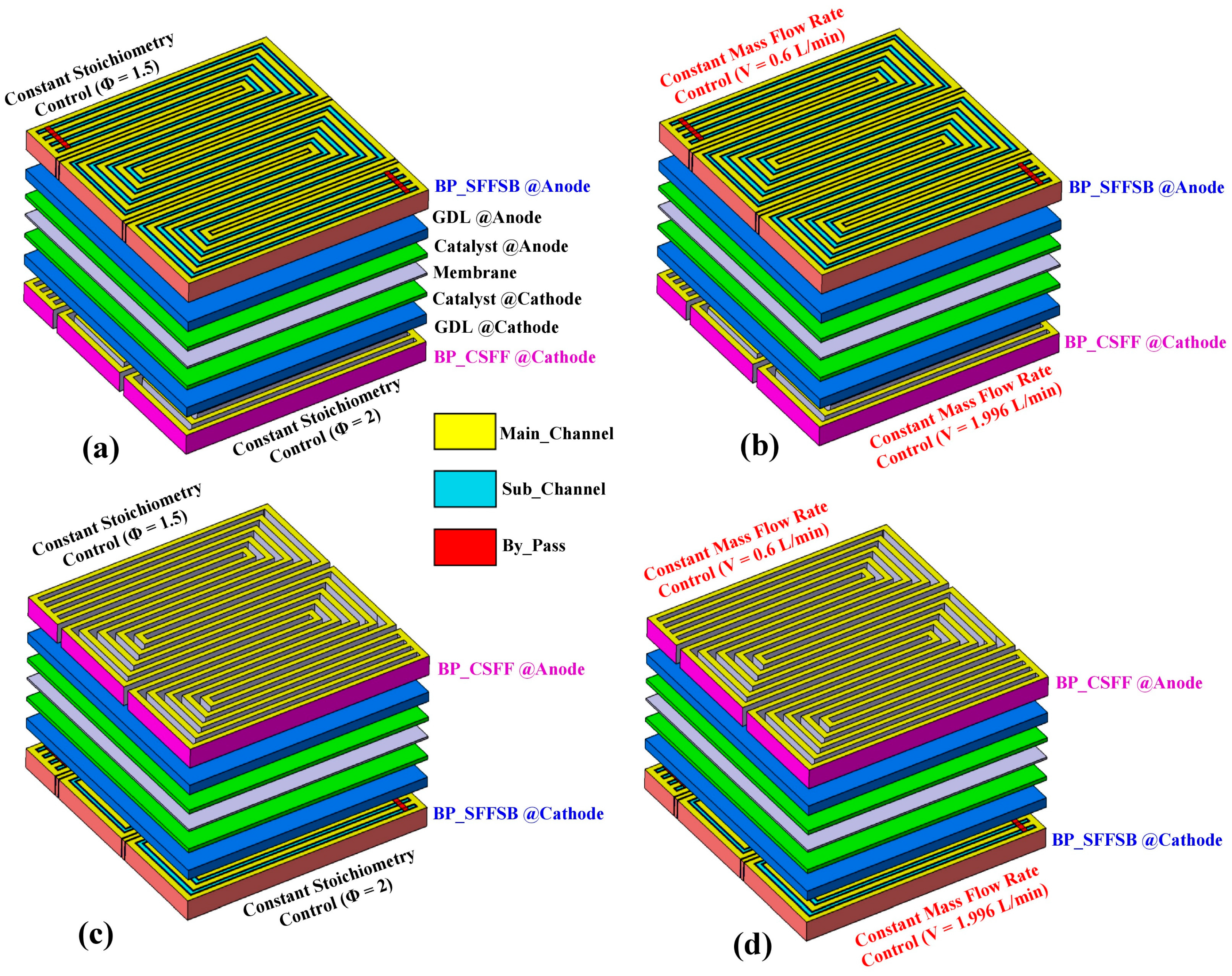

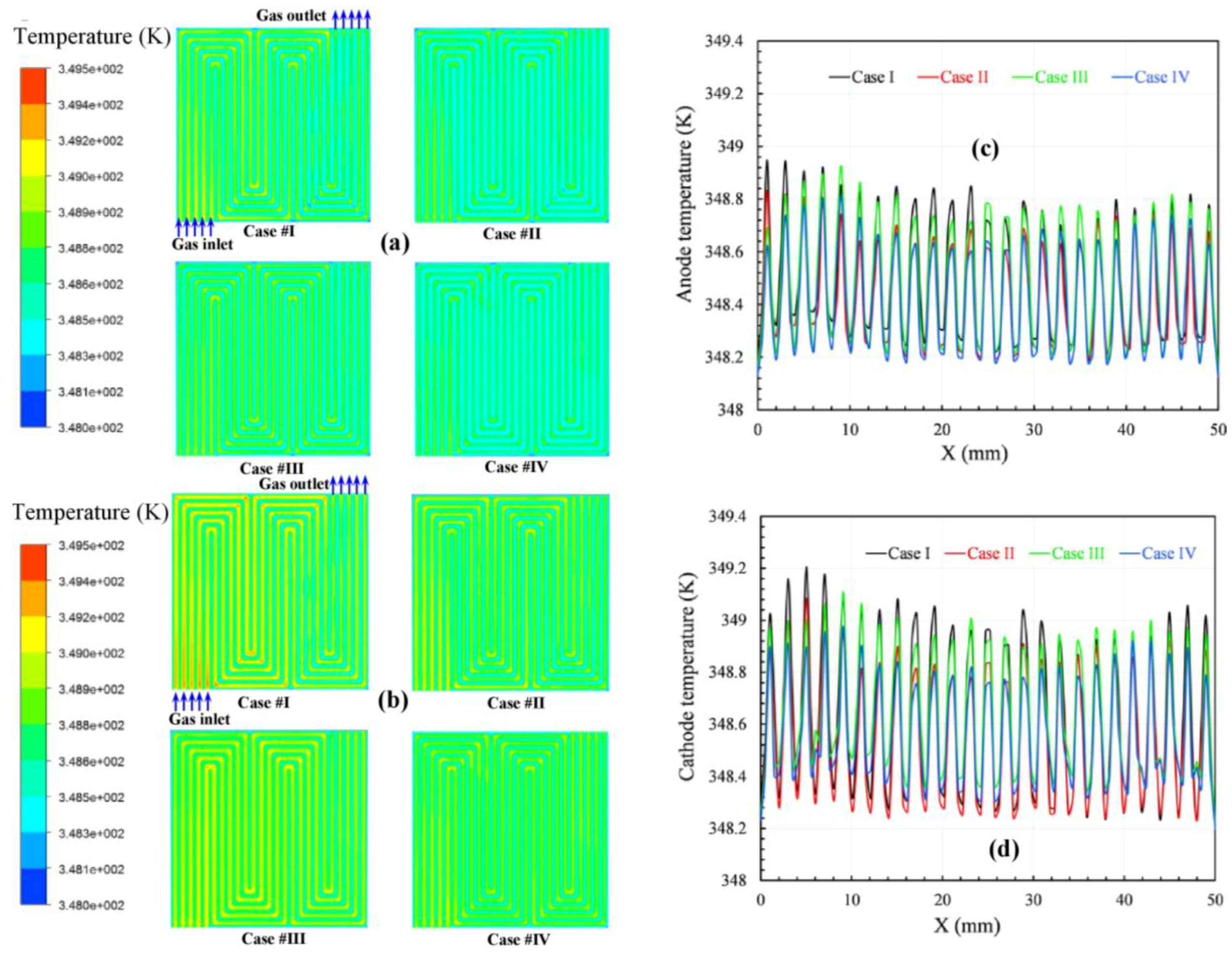
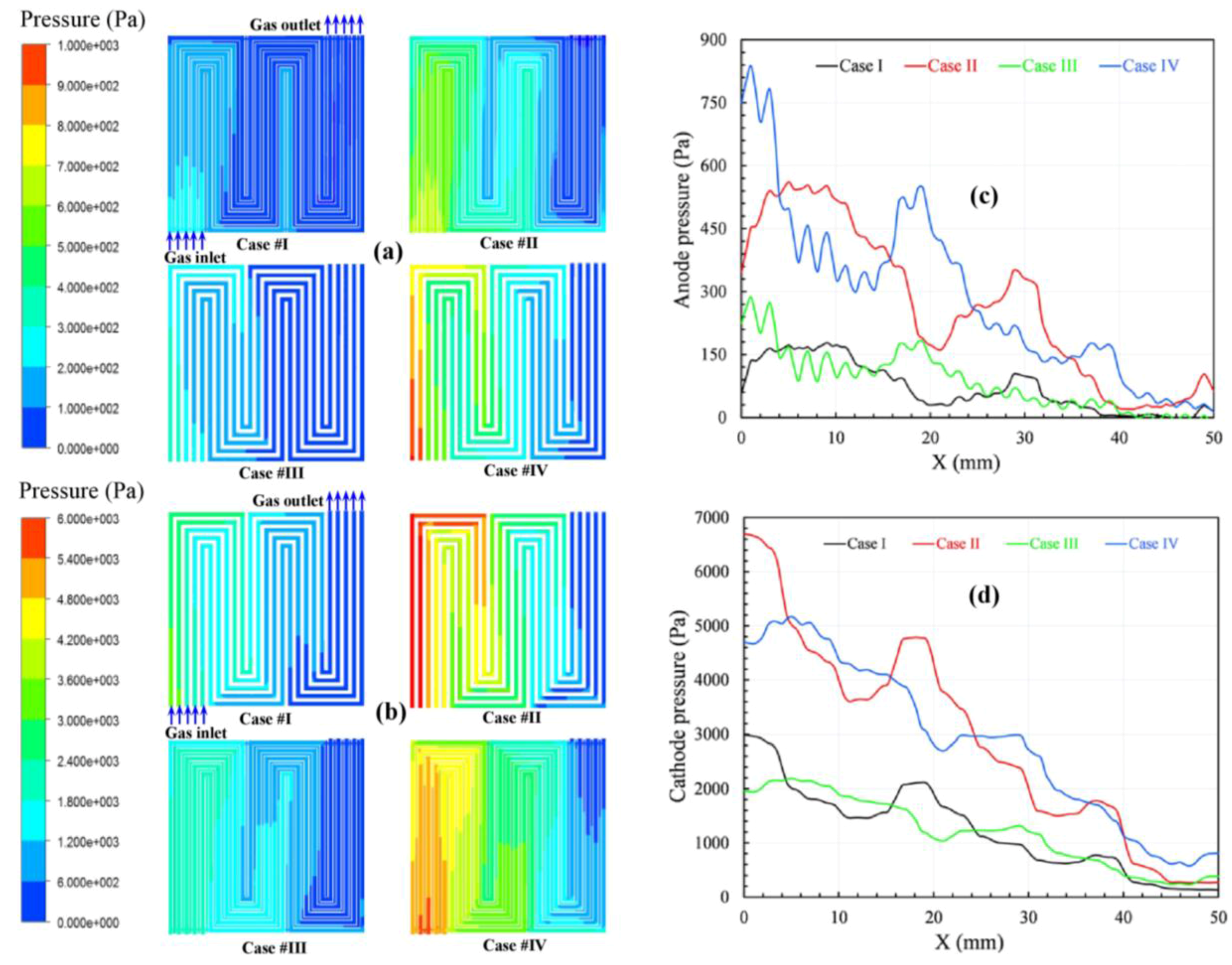

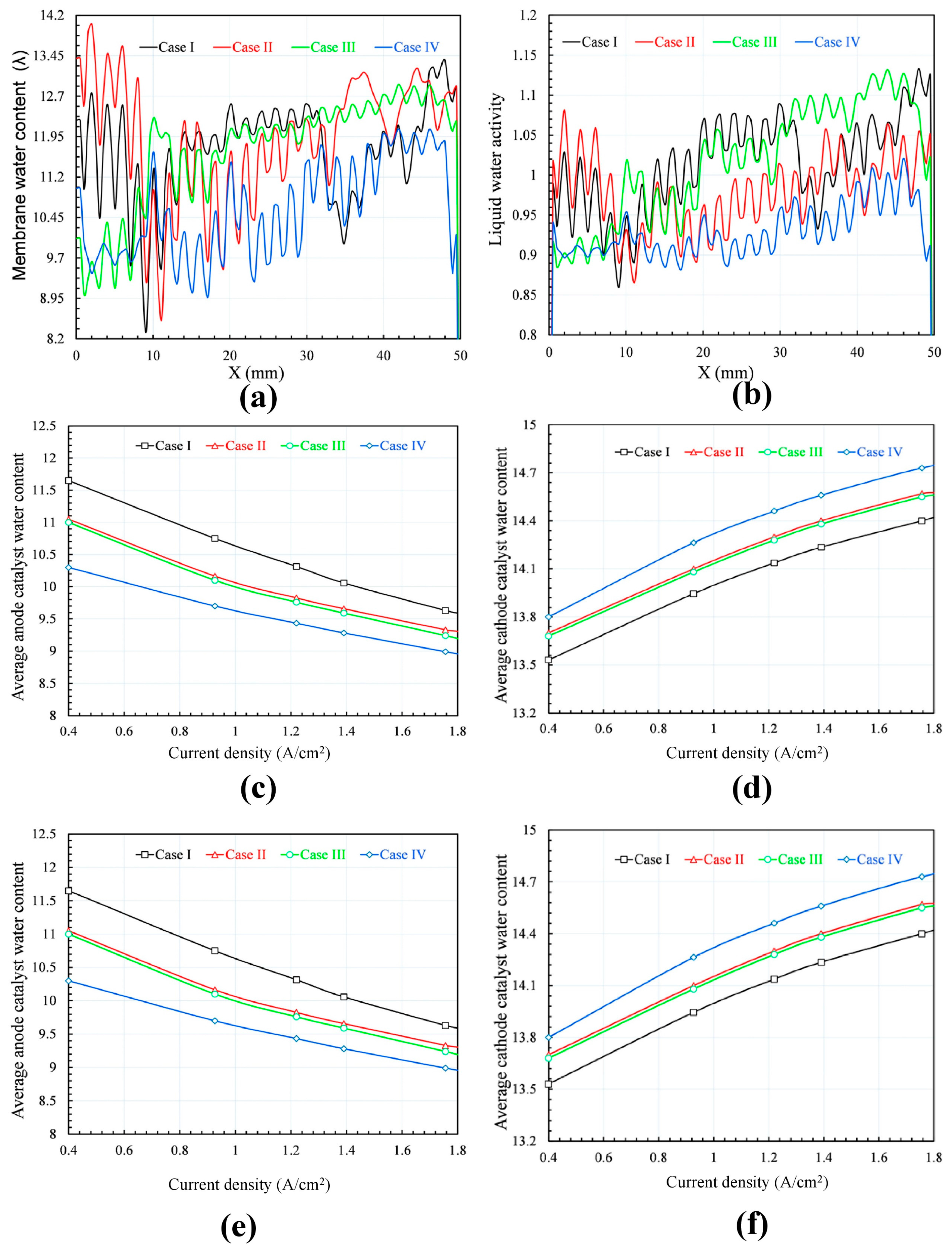
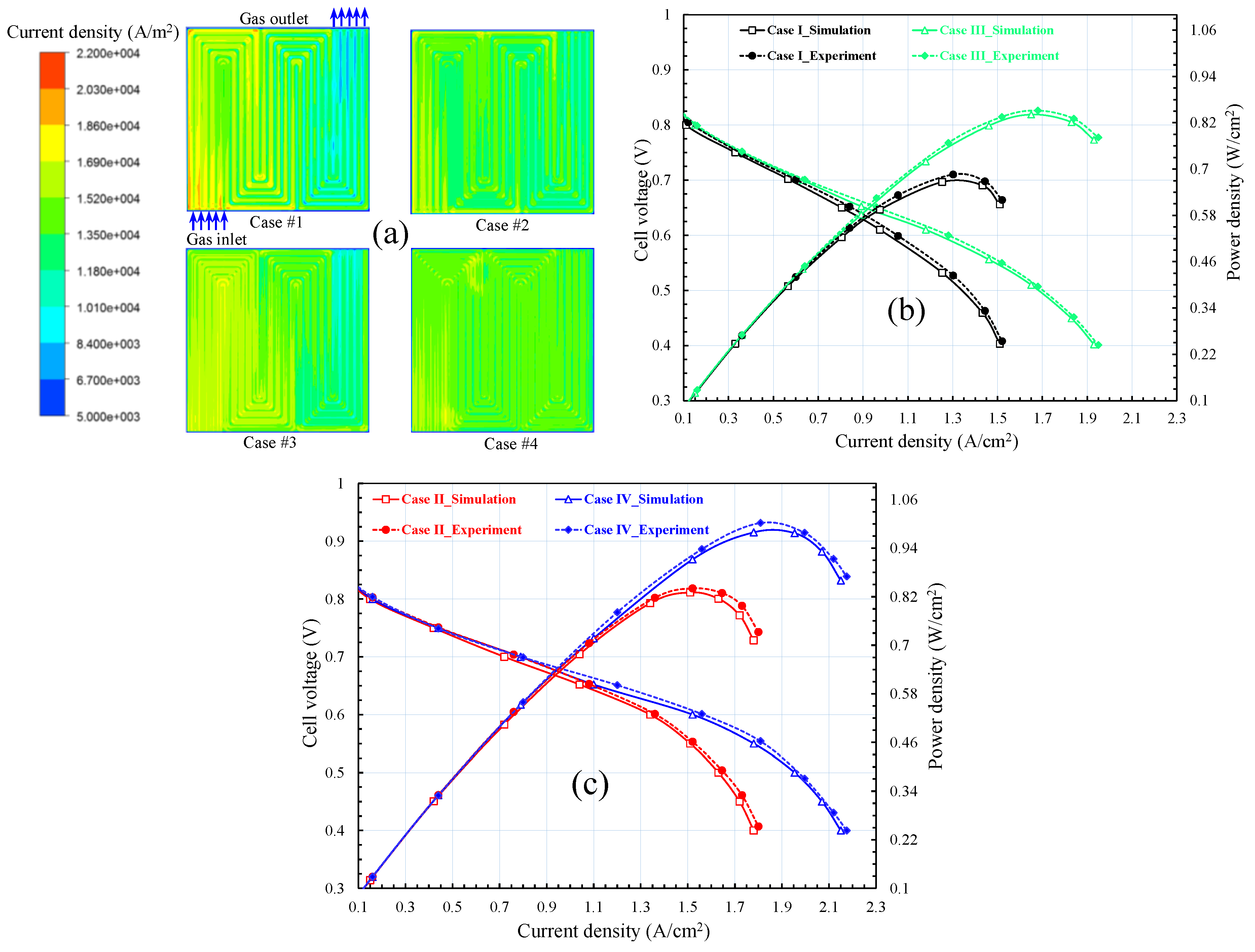
| Flow-Field Patterns | CSFF | SFFSB |
|---|---|---|
| Main channel width (mm) | 1.0 | 1.0 |
| Main channel rib width (mm) | 1.0 | 1.0 |
| Main channel turn rib width (mm) | 1.25 | 1.25 |
| Sub-channel width (mm) | - | 0.5 |
| Sub-channel turn rib width (mm) | - | 0.75 |
| Main channel height (mm) | 0.5 | 0.5 |
| Sub-channel height (mm) | - | 0.334 |
| Part | Length (mm) | Width (mm) | Thickness (mm) |
|---|---|---|---|
| GDL | 50 | 50 | 0.25 |
| Catalyst layer | 50 | 50 | 0.0125 |
| Membrane | 50 | 50 | 0.035 |
| Collector | 64 | 64 | 20 |
| Fuel Cell Component | Parameters | Value |
|---|---|---|
| Current collector | Thermal conductivity (W/(m·K)) | 5.7 |
| Electric conductivity (1/(Ω·m)) | 10,000 | |
| GDL | Thickness after compressed (μm) | 250 |
| Permeability of GDL (m2) | 1.0 × 10−12 | |
| Porosity after compressed (%) | 70 | |
| Diffusion adjustment (%) | 50 | |
| Thermal conductivity of GDL (W/(m·K)) | 0.21 | |
| Membrane electrode assembly | Thickness including catalyst layer (μm) | 50 |
| Thermal conductivity of membrane (W/(m·K)) | 0.15 | |
| Reference diffusivity of H2 (m2/s) | 8 × 10−5 | |
| Reference diffusivity of O2 (m2/s) | 2 × 10−5 | |
| Reference diffusivity of H2O (m2/s) | 5 × 10−5 | |
| Dry membrane density (g/cm3) | 2.0 | |
| Equivalent weight of dry membrane (g/mol) | 1100 | |
| Anode reference current density (A/cm2) | 10,000 | |
| Cathode reference current density (A/cm2) | 200 |
| Parameter | Inlet Conditions | Value |
|---|---|---|
| Anode | Constant mass flow rate inlet (L/min) | 0.6 |
| Constant stoichiometry inlet | 1.5 | |
| Inlet temperature (°C) | 75 | |
| Anode inlet relative humidity (%) | 100 | |
| Cathode | Constant mass flow rate inlet (L/min) | 1.996 |
| Constant stoichiometry inlet | 2 | |
| Inlet temperature (°C) | 75 | |
| Cathode inlet relative humidity (%) | 100 | |
| Operating conditions | Exit pressure (kPa) | 101 |
| Gravitational acceleration (m/s2) | 9.8 | |
| Open circuit voltage (V) | 0.96 | |
| Cell temperature (°C) | 75 |
© 2016 by the authors; licensee MDPI, Basel, Switzerland. This article is an open access article distributed under the terms and conditions of the Creative Commons Attribution (CC-BY) license (http://creativecommons.org/licenses/by/4.0/).
Share and Cite
Vinh, N.D.; Kim, H.-M. Comparison of Numerical and Experimental Studies for Flow-Field Optimization Based on Under-Rib Convection in Polymer Electrolyte Membrane Fuel Cells. Energies 2016, 9, 844. https://doi.org/10.3390/en9100844
Vinh ND, Kim H-M. Comparison of Numerical and Experimental Studies for Flow-Field Optimization Based on Under-Rib Convection in Polymer Electrolyte Membrane Fuel Cells. Energies. 2016; 9(10):844. https://doi.org/10.3390/en9100844
Chicago/Turabian StyleVinh, Nguyen Duy, and Hyung-Man Kim. 2016. "Comparison of Numerical and Experimental Studies for Flow-Field Optimization Based on Under-Rib Convection in Polymer Electrolyte Membrane Fuel Cells" Energies 9, no. 10: 844. https://doi.org/10.3390/en9100844
APA StyleVinh, N. D., & Kim, H.-M. (2016). Comparison of Numerical and Experimental Studies for Flow-Field Optimization Based on Under-Rib Convection in Polymer Electrolyte Membrane Fuel Cells. Energies, 9(10), 844. https://doi.org/10.3390/en9100844





